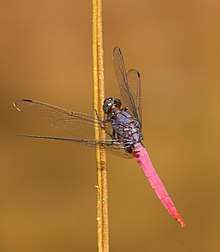Orthetrum pruinosum
Orthetrum pruinosum,[2] the crimson-tailed marsh hawk,[3][4][5] is a species of dragonfly in the family Libellulidae. It is a widespread species occurring from west India to Japan and south to Java and the Sunda Islands.[4][5][6] A molecular phylogenetics study of Orthetrum dragonflies revealed that Orthetrum pruinosum is a cryptic species.[7]
| Orthetrum pruinosum | |
|---|---|
_male_Nepal.jpg) | |
| Male | |
 | |
| Female | |
| Scientific classification | |
| Kingdom: | |
| Phylum: | |
| Class: | |
| Order: | |
| Suborder: | |
| Family: | |
| Genus: | |
| Species: | O. pruinosum |
| Binomial name | |
| Orthetrum pruinosum (Burmeister, 1839) | |
| Synonyms | |
| |

Crimson-tailed Marsh Hawk , Orthetrum pruinosum
Subspecies
Three subspecies are recognized.[1]
- O. p. neglectum (mainland Asia)
- O. p. schneideri (Malay peninsular and Borneo)
- O. p. clelia (Philippines and Taiwan)
Description and habitat
It is a medium-sized dragonfly with dark thorax with slight purple pruinescence and purple colored abdomen. Young males have red abdomen as in Orthetrum chrysis. Females of both species look similar. It breeds in ponds, lakes and sluggish streams.[8][9]
gollark: I mean, if we're registering opinions on school now, I don't like it much.
gollark: Er. Is this a general thing, or what?
gollark: At least on mine, which is "seventh generation" or something.
gollark: Actually, like I said, most of the stuff it displays runs in some weird embedded browser.
gollark: I remember some people had made other browsers run on some Kindle versions, but they weren't much better.
See also
- List of odonates of Sri Lanka
- List of odonates of India
- List of odonata of Kerala
References
- Sharma, G. (2010). "Orthetrum pruinosum". IUCN Red List of Threatened Species. 2010: e.T167097A6301540. doi:10.2305/IUCN.UK.2010-4.RLTS.T167097A6301540.en.
- Martin Schorr; Dennis Paulson. "World Odonata List". University of Puget Sound. Retrieved 12 Oct 2018.
- Subramanian, K. A. (2005). Dragonflies and Damselflies of Peninsular India (PDF).
- "Orthetrum pruinosum Burmeister, 1839". India Biodiversity Portal. Retrieved 2017-02-15.
- "Orthetrum pruinosum Burmeister, 1839". Odonata of India, v. 1.00. Indian Foundation for Butterflies. Retrieved 2017-02-15.
- K.A., Subramanian; K.G., Emiliyamma; R., Babu; C., Radhakrishnan; S.S., Talmale (2018). Atlas of Odonata (Insecta) of the Western Ghats, India. Zoological Survey of India. pp. 355–356. ISBN 9788181714954.
- Hoi Sen Yong; Phaik-Eem Lim; Ji Tan; Yong Foo Ng; Praphathip Eamsobhana & I. Wayan Suana (2014). "Molecular phylogeny of Orthetrum dragonflies reveals cryptic species of Orthetrum pruinosum". Nature. Nature Publishing Group. Scientific Reports 4: Article number: 5553. doi:10.1038/srep05553. PMC 5381552. PMID 24989852.
- C FC Lt. Fraser (1936). The Fauna of British India, including Ceylon and Burma, Odonata Vol. III. Red Lion Court, Fleet Street, London: Taylor and Francis. pp. 311–313.
- C FC Lt. Fraser (1924). A Survey of the Odonate (Dragonfly) Fauna of Western India and Descriptions of Thirty New Species (PDF). p. 432.
| Wikimedia Commons has media related to Orthetrum pruinosum. |
This article is issued from Wikipedia. The text is licensed under Creative Commons - Attribution - Sharealike. Additional terms may apply for the media files.
